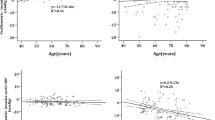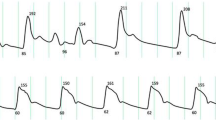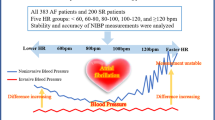Abstract
This study evaluated the impact of ventricular rate (VR) in atrial fibrillation (AF) patients with oscillometric BP measurements. This study included 138 patients with AF and 112 patients with sinus rhythm (SR) who underwent coronary angiography. Left arm BP was measured three times with an oscillometric device, and the average was recorded as the final oscillometric value. At the same time, the average of three intra-aortic BP readings was used as invasive values. Delta BP was the difference between intra-aortic and oscillometric BP. Meanwhile, the BP percentage difference (PD-BP) was calculated with the following formula: PD-BP = (delta BP/intra-aortic BP) × 100%. Based on the VR, four subgroups of AF and SR patients, <80, 80–99, 100–120, and >120 bpm, were created, and the mean PD-BP for both systolic blood pressure (SBP) and diastolic blood pressure (DBP) was significantly higher in the AF group than in the SR group. Moreover, the mean PD-SBP values gradually increased as VR increased in both groups. More importantly, the difference in PD-SBP between the AF and SR groups increased as VR increased: when VR was <80 bpm, the levels were similar (−2.0 ± 3.5 vs. −1.4 ± 2.7 mm Hg, NS), but these values in AF patients were significantly higher when VR was 80–99 bpm (−3.7 ± 5.0 vs. −1.8 ± 2.3 mm Hg, p < 0.05), 100–120 bpm (−6.1 ± 4.3 vs. −2.3 ± 1.9 mm Hg, p < 0.05) and >120 bpm (−7.8 ± 4.9 vs. −2.9 ± 1.7 mm Hg, p < 0.05). The accuracy of oscillometric BP measurements are dependent on the ventricular rate in AF patients even after three measurements, and a higher ventricular rate may result in larger underestimations of oscillometric BP.
This is a preview of subscription content, access via your institution
Access options
Subscribe to this journal
Receive 12 print issues and online access
$259.00 per year
only $21.58 per issue
Buy this article
- Purchase on Springer Link
- Instant access to full article PDF
Prices may be subject to local taxes which are calculated during checkout



Similar content being viewed by others
References
Stergiou GS, Kollias A, Destounis A, Tzamouranis D. Automated blood pressure measurement in atrial fibrillation: a systematic review and meta-analysis. J Hypertens. 2012;30:2074–82.
Pagonas N, Schmidt S, Eysel J, Compton F, Hoffmann C, Seibert F, et al. Impact of atrial fibrillation on the accuracy of oscillometric blood pressure monitoring. Hypertension. 2013;62:579–84.
Kollias A, Stergiou GS. Automated measurement of office, home and ambulatory blood pressure in atrial fibrillation. Clin Exp Pharm Physiol. 2014;41:9–15.
Maselli M, Giantin V, Corrado D, Franchin A, Attanasio F, Pengo V, et al. Reliability of oscillometric blood pressure monitoring in atrial fibrillation patients admitted for electric cardioversion. J Clin Hypertens (Greenwich). 2015;17:558–64.
Alpert BS, Quinn D, Gallick D. Oscillometric blood pressure: a review for clinicians. J Am Soc Hypertens. 2014;8:930–8.
Stergiou GS, Kollias A, Karpettas N. Does atrial fibrillation affect the automated oscillometric blood pressure measurement? Hypertension. 2013;62:e37.
Myers MG, Stergiou GS. Should oscillometric blood pressure monitors be used in patients with atrial fibrillation? J Clin Hypertens (Greenwich). 2015;17:565–6.
Giantin V, Perissinotto E, Franchin A, Baccaglini K, Attanasio F, Maselli M, et al. Ambulatory blood pressure monitoring in elderly patients with chronic atrial fibrillation: is it absolutely contraindicated or a useful tool in clinical practice and research? Hypertens Res. 2013;36:889–94.
Wang XX, Shuai W, Hong K, Li P, Cheng XS, Su H, et al. How to evaluate BP measurements using the oscillometric method in atrial fibrillation: the value of pulse rate variation. Hypertens Res. 2016;39:588–92.
Takahashi H, Yoshika M, Yokoi T. Validation of three automatic devices for the self-measurement of blood pressure according to the European Society of Hypertension International Protocol revision 2010: the Omron HEM-7130, HEM-7320F, and HEM-7500F[J]. Blood Press Monit. 2015;20:92–7.
Dart RA, Alpert B, Quinn D. Effect of mechanical behavior of the brachial artery on blood pressure measurement during cuff inflation and cuff deflation[J]. Blood Press Monit. 2014;19:120.
Luo X, Xiong Q, Xu J, Hong K, Li J, Su H, et al. Differences in heart rate response and recovery after 6-minute walking test between patients with atrial fibrillation and in sinus rhythm. Am J Cardiol. 2018;122:592–6.
Bland JM, Altman DG. Statistical methods for assessing agreement between two methods of clinical measurement. Lancet. 1986;1:307–10.
Badheka AO, Patel NJ, Grover PM, Shah N, Patel N, Mitrani RD, et al. Optimal blood pressure in patients with atrial fibrillation (from the AFFIRM Trial). Am J Cardiol. 2014;114:727–36.
Dąbrowski M, Lewandowski J, Abramczyk P, Łoń I, Gaciong Z, Siński M. Atrial fibrillation does not affect ankle-brachial index measured using the Doppler method. Hypertens Res. 2018;41:60–5.
Pickering TG, Hall JE, Appel LJ, Falkner BE, Graves J, Hill MN, et al. Recommendations for blood pressure measurement in humans and experimental animals: Part 1: Blood pressure measurement in humans: a statement for professionals from the subcommittee of professional and public education of the American Heart Association council on high blood pressure research. Hypertension. 2005;45:142–61.
Picone DS, Schultz MG, Otahal P, Aakhus S, Al-Jumaily AM, Black JA, et al. Accuracy of CUff-measured Blood Pressure: Systematic Reviews And Meta-analyses. J Am Coll Cardiol. 2017;70:572–86.
Kirchhof P, Benussi S, Kotecha D, Ahlsson A, Atar D, Vardas P, et al. 2016 ESC Guidelines for the management of atrial fibrillation developed in collaboration with EACTS. Eur Heart J. 2016;2893–962.
Raamat R, Talts J, Jagomägi K, Kivastik J. Accuracy of some algorithms to determine the oscillometric mean arterial pressure: a theoretical study. Blood Press Monit. 2013;18:50–6.
Acknowledgements
We appreciate all the participants and their relatives in the study and the members of the survey teams in the Second Affiliated Hospital of Nanchang University.
Author information
Authors and Affiliations
Corresponding author
Ethics declarations
Conflict of interest
The authors declare that they have no conflict of interest.
Additional information
Publisher’s note Springer Nature remains neutral with regard to jurisdictional claims in published maps and institutional affiliations.
Supplementary information
Rights and permissions
About this article
Cite this article
Xie, F., Xu, J., Xia, Ll. et al. The impact of atrial fibrillation on accuracy of oscillometric blood pressure measurement: effect of ventricular rate. Hypertens Res 43, 518–524 (2020). https://doi.org/10.1038/s41440-019-0386-4
Received:
Revised:
Accepted:
Published:
Issue Date:
DOI: https://doi.org/10.1038/s41440-019-0386-4
Keywords
This article is cited by
-
Accuracy of oscillometric-based blood pressure monitoring devices: impact of pulse volume, arrhythmia, and respiratory artifact
Journal of Human Hypertension (2023)
-
Home blood pressure monitoring: a position statement from the Korean Society of Hypertension Home Blood Pressure Forum
Clinical Hypertension (2022)
-
Accuracy of non-invasive blood pressure measurement in patients with atrial fibrillation
Journal of Human Hypertension (2022)
-
Validation of an ambulatory blood pressure monitoring device employing a novel method to detect atrial fibrillation
Hypertension Research (2022)
-
The effect of heart rate on blood pressure measurement in patients with atrial fibrillation: a cross-sectional study
Hypertension Research (2022)



